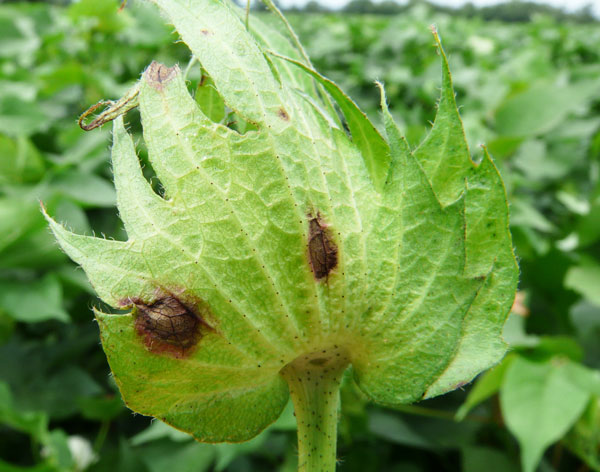August 1, 2013

Rain may be a good thing, but too much can become a problem for Georgia growers when it comes to disease control.
The torrential rains Georgia has experienced in recent weeks have created perfect conditions for fungal and bacterial diseases on peanuts, cotton, corn and soybeans.
And soggy fields are preventing farmers from making timely fungicide applications.
Even when a grower is able to make a fungicide application, the frequent rains can rinse the chemical from the plant without sufficient drying time.
Cotton, peanuts, corn and soybean crops are reaching critical stages of growth where judicious use of fungicides is an important management tool. Rain makes this a very difficult task.
Peanut crop
In July, many peanut growers were delayed by days and even weeks from making timely fungicide applications.
Much of the peanut crop is at least 30 days after planting and some is much older.
Current conditions are perfect for the development and spread of leaf spot diseases, white mold and Rhizoctonia limb rot. University of Georgia plant pathologist Tim Brenneman reports that white mold is quite active in extreme southern Georgia and has even killed young plants.
Want access to the very latest in agriculture news each day? Subscribe to Southeast Farm Press Daily. It’s free!
Corn crop
Southern corn rust has been reported in Georgia fields from across the Coastal Plain from Seminole County to Macon County, from Jefferson County to Wayne County to Pierce County and all points in between.
To my knowledge, southern rust has not caused significant damage yet, but it could easily occur given the widespread distribution of the disease. Farmers’ aggressive use of fungicides has helped contain the disease thus far.
Can reduce yields
Southern corn rust can reduce yields by reducing grain fill and weakening stalks. UGA plant pathologist Dewey Lee and I both believe that growers are fairly safe if the crop is protected until the dough stage with a fungicide.
Northern corn leaf blight and southern corn leaf blight are also found regularly.
Soybean crop
Asian soybean rust has been found in kudzu in Appling and Miller Counties and in northern Florida and in central Alabama. Conditions are extremely favorable for rust and other diseases to spread to soybeans.
Georgia soybean producers should be prepared to make a timely fungicide application to their crop sometime between bloom and early pod development stages.
I strongly believe that with the risk to rust, anthracnose, frogeye leaf spot, and Phomopsis pod and stem blight, judicious use of fungicides is quite important.
Cotton crop
Conditions should be excellent for the development of target spot in cotton again this season. Although none has been diagnosed yet in Georgia, it has been found in the Panhandle of Florida.
To reduce the impact of target spot, the crop must be managed to reduce rank growth and by using fungicides before the disease is well established in the field. This should be done when good coverage of the crop is possible.
Based upon data from last season (which could change), the single best time for an application of a fungicide is the third week of bloom.
To effectively manage target spot, growers should continue to scout their cotton and notify their UGA county Extension agent of suspicious leaf spots.
Ascochyta wet-weather blight is also very common this year. It can look similar to target spot. Cotton growers who have fields where target spot has been problematic in the past are likely to see it again this season. These growers should be very careful in deciding if and when to use a fungicide.
I hope the rains fills Georgia ponds, but we could all use a little dry weather now.
(Bob Kemerait is an Extension plant pathologist with University of Georgia Cooperative Extension.)
More from Southeast Farm Press
Sustainable practices will help farmers' profitability
Wet weather favoring frogeye leaf spot in soybeans
Richard Jameson: Sunbelt Farmer of the Year for Tennessee
Will Harris: Sunbelt Expo Farmer of the Year for Georgia
You May Also Like




